There is really no better place in the world to experience exotic flora and fauna in their tropical environment! Malaysia has a number of beautiful National Parks from tropical rainforests and mangrove reserves to Marine Parks. Just a few degrees north of the equator, the lush rainforests and the warm oceans set the perfect backdrop to watch wildlife in their natural habitat.
It is therefore not shocking that almost 75% of Malaysia’s land area is still forested, with approximately 60% of that being virgin rainforest. A signatory to the Rio Summit in 1992, Malaysia has promised to retain a minimum of 50% of its forests and tree cover as its contribution to the global concern for conservation. As one of the twelve mega-biologically diverse countries in the world, Malaysia is able to boast at least 15,000 species of plants, 286 species of mammals, 150,000 species of invertebrates, and 4,000 species of fishes. Not surprisingly, it is a point of pride for Malaysia that this astonishing level of biodiversity is found in Malaysia’s National Parks.
Among the largest and best-known tropical flora and fauna here are the Sun Bear, the Orangutan, the Sumatran Rhinoceros, the Rainforest Tarantulas, the Malayan Tiger and the Proboscis Monkey. Borneo is especially well known for the world’s biggest flower, the Rafflesia.
Aside from the diverse flora and fauna, Malaysia’s National Parks also offer a large range of outside activities, from activities as challenging as rock climbing and white water rafting to pastimes as calm as bird watching and river cruising. Outdoor professionals, who are equipped with the newest gear, can guide you through all of these activities. If you are looking for rich and exotic outdoor experiences in balmy tropical weather, the time is now, the place is Malaysia.
Key Tips
Take note of the rainy season when planning excursions and always bring along rain gear. Although the weather can be unpredictable, the monsoon season falls from September to December on the West Coast of the Peninsula. There is a distinct monsoon on the East Coast from December to February, while the rainy season in Borneo takes place in the first quarter of the year.
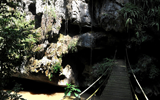 |
Kenong Rimba Park Covering an area of 121 sq kilometres in the Kenong Valley, Kenong Rimba Park lies in the south-west of Taman Negara. Within the park are some magnificent limestone caves. The sense of tranquility and quiet solitude are broken only by the chirping of birds and the cascading waterfalls. Each limestone cave is situated about half an hour's trek from each other. The most striking is the Gua Batu Tinggi, which resembles a dug-out boat. The Sungai Kenong River passes though this cave. Local folklore has it that the cave was formed when a boat carrying the Kings messenger from Pekan was turned into stone. This cave is approximately 122 to 152 metres above sea level. Here you can find a variety of plant life that includes orchids, fig trees and epiphytes. |
|
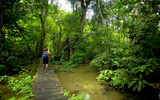 |
Niah National Park Over 400km up the coast from Kuching, hidden in the forests of Miri, are the Niah Caves. The park covers a vast swathe of 3,140 hectares of peat swamp, dipterocarp forests, as well as the massive limestone outcroppings within which the giant Niah caves are concealed. The caves consist of one big cave (The Great Cave) and some smaller caves. In 1958, archeologists discovered evidence of human occupation of the caves dating back some 40,000 years. Rock paintings were found in what has become known as the Painted Cave, and the discovery of several small canoe-like coffins (death ships) indicate that this site was once used as a burial ground. |
|
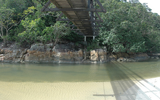 |
Penang National Park |
|
 |
Pulau Payar Marine Park The sprinkling of jade green islands that makes up Pulau Payar lies just 30km south-east of Langkawi. It's just a 1-hour boat ride out to the best marine park on Malaysia's West Coast, making it an ideal choice for a day outing. This well-preserved, uninhabited marine park extends over a number of islands, with Pulau Payar being the largest. Your base out here is the floating platform moored off Pulau Payar. But the real attraction of this platform lies below sea level. Step into the underwater observation chamber to view the marine life surrounding a reef. Want to get even closer to the swirl of fishes that make these corals their home? Grab a mask, a snorkel and fins and join the spectacle! |
|
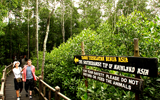 |
Tanjung Piai National Park, Johor Located 90km south of Johor Bahru's city centre, Tanjung Piai's natural wonders have been gazzetted into a National Park. Visitors can see different habitats here, especially for enthusiasts interested in mangrove dwelling. Mangroves, important for their resilience, are also one of the maintstays to sustainable growth of the various mangrove wildlife. It also serves to protect land from the fierce onslaught of the wild sea. Make sure to bring good walking shoes, to enjoy the beautiful mangroves. Platforms are built through the park so visitors can walk around in comfort. |
|
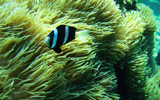 |
Tunku Abdul Rahman Marine Park The Tunku Abdul Rahman park comprises a group of five islands located only 20 minutes away from Kota Kinabalu, Sabah's capital. The park is spread over 4,929 hectares, two thirds of which is sea. The five idyllic islands, Manukan, Mamutik, Sulug, Gaya and Sapi have soft white beaches and are teeming with fish and coral, perfect for beginner divers as well as snorkellers and picnickers. Gaya and Sapi Islands also have hiking trails through their pristine jungles. These islands are home to a variety of flora and fauna, including one of the most intriguing birds, the Megapode or Burung Tambun, a chicken lookalike with large feet and makes a meowing sound like a cat. |
|
For a complete listing of national parks in Malaysia, please click here.





